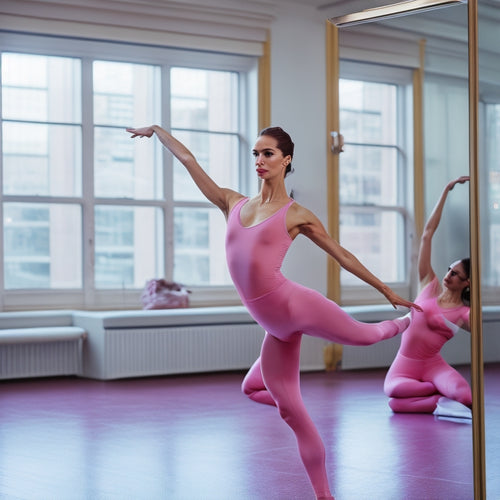
5 Best Nutrition Secrets for Optimal Movement Performance
Share
When you're pushing your body to new heights, every bite counts. Did you know that a single misstep in your nutrition plan can undermine even the most rigorous training regimen? As a dancer, you know that peak movement performance requires more than just technical skill - it demands sustained energy, flexibility, and resilience. But what if you could maximize your full potential by fine-tuning your nutrition strategy? From macronutrient ratios to hydration hacks, there are secrets to enhancing peak performance. Let's explore the top nutrition secrets to take your movement to the next level.
Key Takeaways
• Focus on nutrient-dense foods, including complex carbohydrates, lean protein, and healthy fats, for sustained energy and endurance.
• Hydrate before feeling thirsty, and time your hydration intake to maintain peak function and flexibility.
• Consume Flexibility Foods rich in omega-3 fatty acids, vitamin C, and beta-carotene to enhance ease of movement and precision.
• Optimize macronutrient ratios, allocating 55-65% of daily calories to complex carbohydrates, 15-20% to protein, and 20-25% to healthy fats.
• Include post-workout snacks like bananas, dates, and nuts to refuel and support muscle recovery for optimal movement performance.
Eating for Energy and Endurance
When you're pushing yourself to new heights in your fitness journey, every morsel of food you eat can either make or break your performance, and that's why fueling your body with the right energy-boosting foods is essential for peak endurance. A well-planned diet can greatly impact your exercise performance, allowing you to power through even the toughest workouts.
For best energy and endurance, it's vital to focus on nutrient-dense foods that provide a balance of complex carbohydrates, lean protein, and healthy fats. As a dancer, you need fuel that's easily digestible and won't cause an energy crash mid-workout.
Post-workout snacks like bananas, dates, and nuts provide a natural energy boost to help your body recover. In the morning, fuel up with a balanced meal that includes complex carbs, such as whole-grain toast with avocado and eggs, to give you sustained energy throughout your workout.
Hydration Strategies for Dancers
As you dance, every drop of water counts, and even mild dehydration can lead to decreased flexibility, cramping, and fatigue, ultimately affecting your overall performance. Staying hydrated is essential to maintain your body's peak function, especially during intense dance sessions.
To guarantee you're properly hydrated, follow these hydration strategies:
-
Hydrate before you feel thirsty: Drink water regularly throughout the day, rather than waiting until you feel parched. This will help maintain your electrolyte balance and prevent dehydration.
-
Time your hydration: Drink 17-20 ounces of water 2-3 hours before dancing, and 7-10 ounces every 10-15 minutes during your dance session.
-
Electrolyte-rich drinks are a must: Include electrolyte-rich beverages, like sports drinks or coconut water, in your hydration plan to replenish lost electrolytes and maintain the correct balance.
- Monitor your urine output: If your urine is dark yellow or you're not urinating frequently enough, it may be a sign that you're not drinking enough water.
Fueling Your Body for Flexibility
By fueling your body with the right nutrients, you can enhance your flexibility and range of motion, allowing you to move with greater ease and precision. A well-nourished body is better equipped to handle the demands of physical activity, reducing the risk of injury and improving overall performance.
To optimize flexibility, focus on consuming Flexibility Foods rich in omega-3 fatty acids, vitamin C, and beta-carotene. These nutrients help reduce inflammation, promote collagen production, and support connective tissue health.
Incorporate Stretching Snacks into your daily routine, such as nuts, seeds, and fruits high in antioxidants and fiber. These snacks provide a natural energy boost, support muscle function, and promote healthy digestion.
Additionally, stay hydrated by drinking plenty of water throughout the day. Adequate hydration is essential for maintaining flexibility and range of motion.
Nutrition for Injury Prevention
One major obstacle to peak movement performance is injury, and fueling your body with the right nutrients can play a crucial role in preventing it. When you're injured, your performance suffers, and your body's ability to recover is compromised. Nutrition plays a critical role in reducing the risk of injury and promoting top-notch movement performance.
To prevent injuries, focus on the following nutrients and strategies:
-
Omega-3 fatty acids: Reduce inflammation, a major contributor to injury
-
Antioxidants: Neutralize free radicals that can lead to muscle damage and inflammation
-
Collagen-boosting nutrients: Support connective tissue health and resilience
- Gut-friendly foods: Promote gut resilience, which is linked to reduced inflammation and improved immune function, both crucial for injury prevention
In addition, monitoring injury biomarkers, such as creatine kinase and C-reactive protein, can help you identify potential issues before they become full-blown injuries.
Optimizing Macronutrient Ratios
You've optimized your nutrition plan to prevent injuries, now it's time to fine-tune your macronutrient ratios to fuel peak movement performance. Macro balancing is essential to make sure you're providing your body with the necessary energy sources to power through intense movements.
Aim to allocate your daily calories into the ideal ratio of carbohydrates, protein, and fats. A general guideline is to focus on 55-65% of daily calories from complex carbohydrates, 15-20% from protein, and 20-25% from healthy fats. However, this ratio may vary depending on your specific movement patterns and goals.
To take it to the next level, incorporate nutrition periodization into your plan. This involves adjusting your macronutrient ratios based on your training phases. For example, during high-intensity training periods, you may increase your carbohydrate intake to ensure sufficient energy stores. Conversely, during recovery phases, you may shift towards a higher protein intake to support muscle repair.
Frequently Asked Questions
How Can I Avoid Digestive Issues During Intense Physical Activity?
To avoid digestive issues during intense physical activity, you'll want to prioritize a healthy gut barrier by fueling with easily digestible carbs and staying hydrated with evidence-based hydration strategies, like drinking 17-20 oz of water 2-3 hours before exercise.
What Are the Best Snack Options for Quick Energy Boosts?
"Good luck surviving on just coffee fumes alone! You need real snacks, like Energy Chews for a quick pick-me-up or Post Workout Muffins to replenish carbs and protein - your body (and taste buds) will thank you!"
Can Certain Foods Help Reduce Muscle Soreness After Exercise?
You can reduce muscle soreness after exercise by consuming foods rich in anti-inflammatory compounds, such as turmeric, ginger, and omega-3 fatty acids, which can be easily incorporated into post-workout smoothies to aid in recovery.
Are There Specific Nutrients That Support Tendon Health?
As you navigate the complex labyrinth of tendon health, you'll discover that collagen supplements and Vitamin C benefits serve as trusted guides, providing structural support and antioxidant shields to safeguard your tendons from the wear and tear of exercise.
How Does Nutrition Impact Mental Focus and Concentration During Exercise?
When you fuel your brain with excellent nutrition, you enhance mental focus and concentration during exercise. Consuming brain fuel like omega-3 fatty acids, antioxidants, and complex carbs supports neurotransmitters, allowing you to stay sharp and focused.
Related Posts
-

Why Online Dance Makeup Courses Are a Game-Changer
You're about to reveal the secret to elevating your dance makeup artistry! Online dance makeup courses have revolutio...
-

Why Digital Solutions Are a Game-Changer
By integrating digital solutions into your operations, you can revolutionize your workflows, discover new revenue str...
-

Dance Practice Wear Picks for Maximum Comfort and Performance
When choosing dance practice wear, you want gear that optimizes comfort and performance. Opt for moisture-wicking fab...


